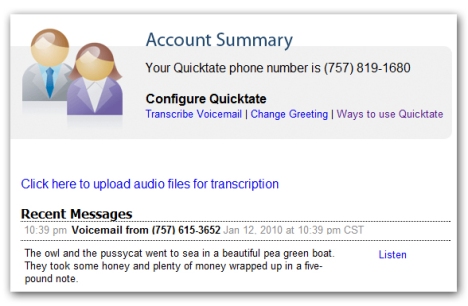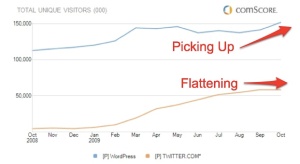CHICAGO – Could it be that blogs have become online fodder for the — gasp! — more mature reader?
A new study has found that young people are losing interest in long-form blogging, as their communication habits have become increasingly brief, and mobile. Tech experts say it doesn’t mean blogging is going away. Rather, it’s gone the way of the telephone and e-mail — still useful, just not sexy.
“Remember when ‘You’ve got mail!’ used to produce a moment of enthusiasm and not dread?” asks Danah Boyd, a fellow at Harvard University’s Berkman Center for Internet and Society. Now when it comes to blogs, she says, “people focus on using them for what they’re good for and turning to other channels for more exciting things.”
Those channels might include anything from social networking sites to others that feature games or video.
The study, released Wednesday by the Pew Internet & American Life Project, found that 14 percent of Internet youths, ages 12 to 17, now say they blog, compared with just over a quarter who did so in 2006. And only about half in that age group say they comment on friends’ blogs, down from three-quarters who did so four years ago.
Pew found a similar drop in blogging among 18- to 29-year-olds.
Overall, Pew estimates that roughly one in 10 online adults maintain a blog — a number that has remained consistent since 2005, when blogs became a more mainstream activity. In the U.S., that would mean there are more than 30 million adults who blog.
“That’s a pretty remarkable thing to have gone from zero to 30 million in the last 10 years,” says David Sifry, founder of blog search site Technorati.
But according to the data, that population is aging.
The Pew study found, for instance, that the percentage of Internet users age 30 and older who maintain a blog increased from 7 percent in 2007 to 11 percent in 2009.
Pew’s over-18 data, collected in the last half of last year, were based on interviews with 2,253 adults and have a margin of error of plus or minus 2.7 percentage points. The under-18 data came from phone interviews with 800 12- to 17-year-olds and their parents. The margin of error for that data was plus or minus 3.8 percentage points.
So why are young people less interested in blogging?
The explosion of social networking is one obvious answer. The Pew survey found that nearly three-quarters of 12- to 17-year-olds who have access to the Internet use social networking sites, such as Facebook. That compares with 55 percent four years ago.
With social networking has come the ability to do a quick status update and that has “kind of sucked the life out of long-form blogging,” says Amanda Lenhart, a Pew senior researcher and lead author of the latest study.
More young people are also accessing the Internet from their mobile phones, only increasing the need for brevity. The survey found, for instance, that half of 18- to 29-year-olds had done so.
All of that rings true to Sarah Rondeau, a freshman at the College of the Holy Cross in Worcester, Mass.
“It’s a matter of typing quickly. People these days don’t find reading that fun,” the 18-year-old student says. She loves Facebook and has recently started using Twitter to share pictures of her dorm room and blurbs about campus life, which are, in turn, shared on the Holy Cross Web site for prospective students.
Meanwhile, New Yorker Jackie Huang hasn’t made a posting on her long-form blog in two years, and she now uses Facebook and Twitter because her friends do — though she’s still not too hot on tweeting.
Now 25, she started blogging when she was a college freshman, using Xanga and then WordPress to tell friends, family and a few strangers about anything from travel experiences to pop culture to politics.
“My blog was my own little soapbox,” says Huang, who now works for a communications agency. “Unfortunately, I don’t think I’m interesting enough for my followers to want to know where I am every hour of the day and what I’m thinking. I’m not Ashton Kutcher, and I don’t post racy pictures of Demi Moore in her skivvies.”
Few doubt that blogging will die. Lenhart suspects that those who blog for personal reasons may focus more on events — a wedding, a trip, a baby’s birth.
Arax-Rae Van Buren, who writes about trends, travel and food on her Kiss and Type blog, is relaunching her site with a mobile audience in mind. “It is imperative that the site design is translatable to a phone,” says the 24-year-old New Yorker.
There also are early signs that “microblogging” on sites such as Twitter might actually create long-form bloggers out of people who get frustrated by the constraints of the 140-word limit. Already, sites such as Tumblr and FriendFeed have emerged to allow for expansion of thought and content, though it remains to be seen whether those services will catch on with younger people.
“Blogging is actually a quite involved form of self-expression. It takes a lot of time and effort,” says Eszter Hargittai, an associate professor of communications studies at Northwestern University.
She and other tech experts also suspect that fewer young people have an interest in sharing their every thought with the whole world.
“Five years ago blogging was a club,” says Sifry of Technorati. “There was this wonderful, delicious feeling of being able to talk privately or semi-privately with people who shared your interests. And there were few consequences of being able to share with your friends on a blog.
“I think we’re seeing a deeper awareness of the perception of privacy and how that can affect your life if it’s violated.”
By MARTHA IRVINE
Filed under: Hot news | Tagged: Blogging, social network | 3 Comments »






